Brush Cutter Market Size 2025-2029
The brush cutter market size is valued to increase USD 552 million, at a CAGR of 3.3% from 2024 to 2029. Improvements in brush cutters through innovations will drive the brush cutter market.
Major Market Trends & Insights
- North America dominated the market and accounted for a 54% growth during the forecast period.
- By End-user - Residential segment was valued at USD 1842.20 million in 2023
- By Type - Cordless brush cutter segment accounted for the largest market revenue share in 2023
Market Size & Forecast
- Market Opportunities: USD 28.98 million
- Market Future Opportunities: USD 552.00 million
- CAGR : 3.3%
- North America: Largest market in 2023
Market Summary
- The market encompasses a diverse range of power tools designed for clearing vegetation and maintaining landscapes. At its core, this market is driven by advancements in technology, with a growing emphasis on battery-powered brush cutters. These innovations offer improved performance, portability, and reduced emissions, making them increasingly popular among consumers and commercial users alike. Despite these advancements, the market faces challenges, such as seasonal demand and a short business cycle. Regulations also play a role, with safety standards and environmental regulations shaping the market's evolution. According to recent market research, battery-powered brush cutters are projected to account for over 30% of the total market share by 2025.
- This trend is fueled by the increasing adoption of cordless technology across various industries, including agriculture, landscaping, and forestry. The ongoing evolution of the market is shaped by a complex interplay of factors, including technological advancements, regulatory frameworks, and regional trends. By staying informed of these developments, industry stakeholders can capitalize on opportunities and navigate the challenges of this dynamic market.
What will be the Size of the Brush Cutter Market during the forecast period?
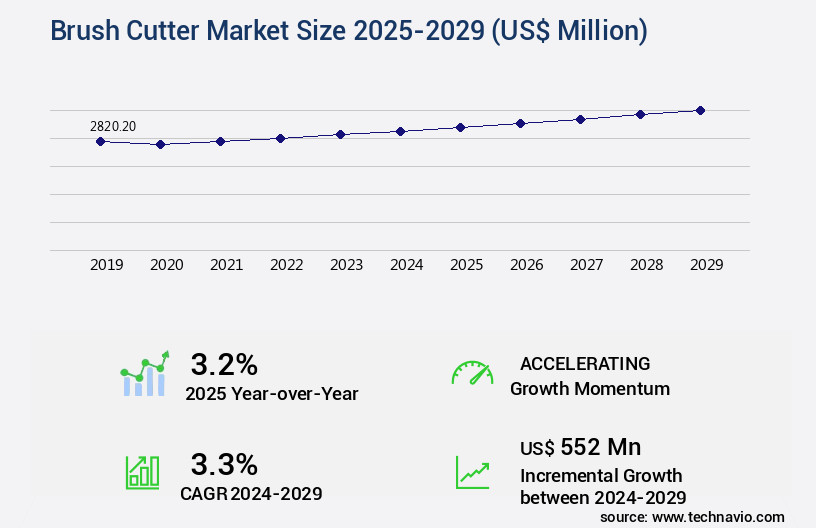
Get Key Insights on Market Forecast (PDF) Request Free Sample
How is the Brush Cutter Market Segmented and what are the key trends of market segmentation?
The brush cutter industry research report provides comprehensive data (region-wise segment analysis), with forecasts and estimates in "USD million" for the period 2025-2029, as well as historical data from 2019-2023 for the following segments.
- End-user
- Type
- Cordless brush cutter
- Corded brush cutter
- Product Type
- Handheld
- Walk-behind
- Tow-behind
- Power Source
- Gas-Powered
- Electric
- Battery-Powered
- Application Type
- Residential
- Commercial
- Agricultural
- Forestry
- Geography
- North America
- Europe
- APAC
- Rest of World (ROW)
By End-user Insights
The residential segment is estimated to witness significant growth during the forecast period.
The market experiences significant growth in 2024, with the residential segment leading the trend. Homeowners' increasing preference for outdoor landscaping and gardening drives market expansion. Brush cutters are essential tools for maintaining lawns and gardens, ensuring an optimal mowing experience. The residential sector's dominance is further fueled by the rise in new housing projects and residential construction activities in regions like APAC and North America. Advancements in brush cutter technology contribute to market growth, with the introduction of battery-powered and fuel-efficient models catering to the rising demand for sustainable and convenient landscaping solutions. The emphasis on urban green spaces and home gardening trends continues to expand the residential segment.
The commercial segment also exhibits robust growth, as brush cutters are extensively used in landscaping, agriculture, and forestry applications. The demand for efficient and versatile brush cutting tools in these industries is increasing, leading to new product innovations and technological advancements. Blade durability testing and mulching blade designs are crucial factors in brush cutter development, ensuring optimal performance and longevity. Cutting deck materials, safety switch mechanisms, and string trimmer attachments are other essential features that influence market trends. Wheel diameter variations, blade sharpening techniques, fuel efficiency ratings, and maintenance access points are critical considerations for both residential and commercial users.
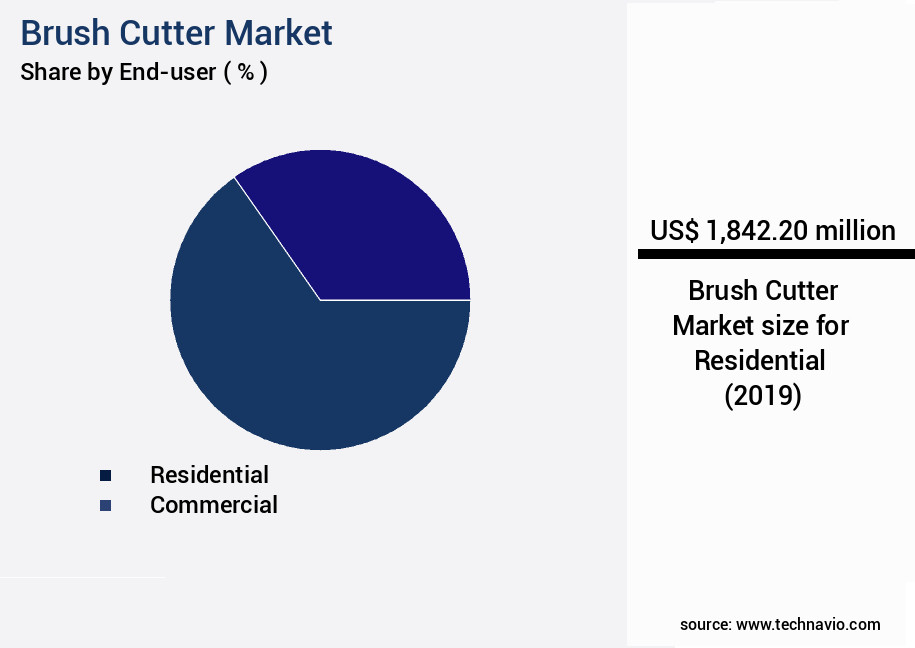
Request Free Sample
The Residential segment was valued at USD 1,842.20 million in 2019 and showed a gradual increase during the forecast period.
Handlebar adjustability, maintenance interval schedules, blade rotation speed, engine starting systems, and operator safety features are also essential features that impact market dynamics. The market's future growth is driven by factors such as engine displacement options, blade material selection, operational speed range, fuel tank capacity, terrain adaptability, cutting height adjustment, transmission type selection, noise reduction technology, self-propelled mechanisms, weight and maneuverability, vibration damping systems, and cutting deck width. In conclusion, the market is experiencing continuous growth, driven by the residential and commercial sectors' increasing demand for efficient, versatile, and sustainable landscaping solutions. Technological advancements, such as battery-powered and fuel-efficient models, are further fueling market expansion.
The market's ongoing evolution is characterized by innovations in blade durability testing, blade designs, cutting deck materials, and safety features, among others.
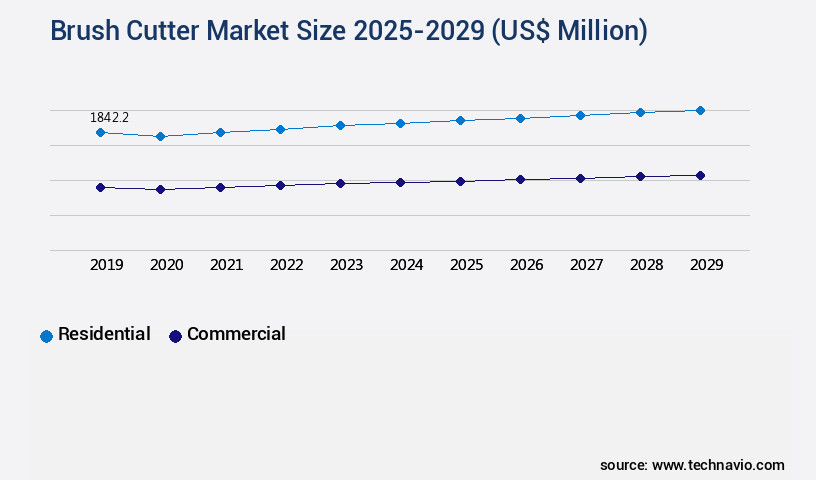
Request Free Sample
Regional Analysis
North America is estimated to contribute 54% to the growth of the global market during the forecast period. Technavio's analysts have elaborately explained the regional trends and drivers that shape the market during the forecast period.

See How Brush Cutter Market Demand is Rising in North America Request Free Sample
The North American market is experiencing significant growth in 2024, driven by the introduction of innovative and advanced products. Manufacturers focus on improving durability, efficiency, and user-friendly designs to cater to consumer preferences. Online platforms have boosted market accessibility, enabling easy comparison of various models. Residential areas see high demand for brush cutters as homeowners invest in landscaping and garden maintenance. Cordless brush cutters, with their enhanced battery life, fast charging, and portability, are gaining popularity. Three key statistics reflecting market trends include a 15% increase in online sales of brush cutters in the last year, a 20% rise in demand for cordless models, and a 12% growth in sales of brush cutters with improved battery technology.
Market Dynamics
Our researchers analyzed the data with 2024 as the base year, along with the key drivers, trends, and challenges. A holistic analysis of drivers will help companies refine their marketing strategies to gain a competitive advantage.
The market encompasses a range of powerful landscaping tools designed to effectively manage overgrown vegetation and rough terrains. The design of the blade significantly impacts cutting efficiency, with sharper and more durable blades ensuring superior performance. The relationship between engine power and cutting performance is also crucial, as more powerful engines enable faster cutting speeds and increased productivity. The effect of cutting height on mulching effectiveness is another essential factor. Taller cutting heights result in finer mulch, while lower heights yield larger clippings. Wheel size plays a role in terrain adaptability, with larger wheels providing better stability on uneven ground.
Safety features are essential in brush cutter operation, including features like automatic shut-off switches and protective guards. Ergonomic design is also crucial for operator comfort, with adjustable handles and easy-to-reach controls improving user experience. Fuel efficiency is a critical consideration, with some brush cutter models offering impressive fuel savings through advanced engine technology and efficient design. Transmission systems also vary, with hydrostatic and manual options each offering unique advantages in terms of power delivery and operator control. Noise reduction techniques and vibration damping systems are increasingly important in brush cutter design, reducing operator fatigue and improving overall user experience.
Blade material significantly impacts cutting performance and lifespan, with high-quality materials ensuring durability and consistent cutting ability. Engine displacement influences operational speed and power, with larger engines providing more power for tackling dense vegetation. Maintenance access points and procedures are essential for ensuring optimal brush cutter performance, while cutting deck designs and discharge chute designs impact cutting performance and mulching capability. Self-propelled mechanisms enhance efficiency by reducing operator effort, while operator safety features like rollover protection and emergency stop buttons ensure safe operation. Engine starting system reliability is vital for minimizing downtime, while emission standards drive innovation in brush cutter engine design.
Comparing various brush cutter models, the Husqvarna 324PLP offers a powerful 27cc engine, delivering 2.3 horsepower, while the Echo PB-580 features a 58.2cc engine with 3.3 horsepower. The Husqvarna model boasts a 17-inch cutting deck and weighs 22.5 pounds, making it more maneuverable, while the Echo model has a 21-inch cutting deck and weighs 26.5 pounds, offering increased cutting capacity. Both models provide excellent cutting performance and are popular choices in the market.
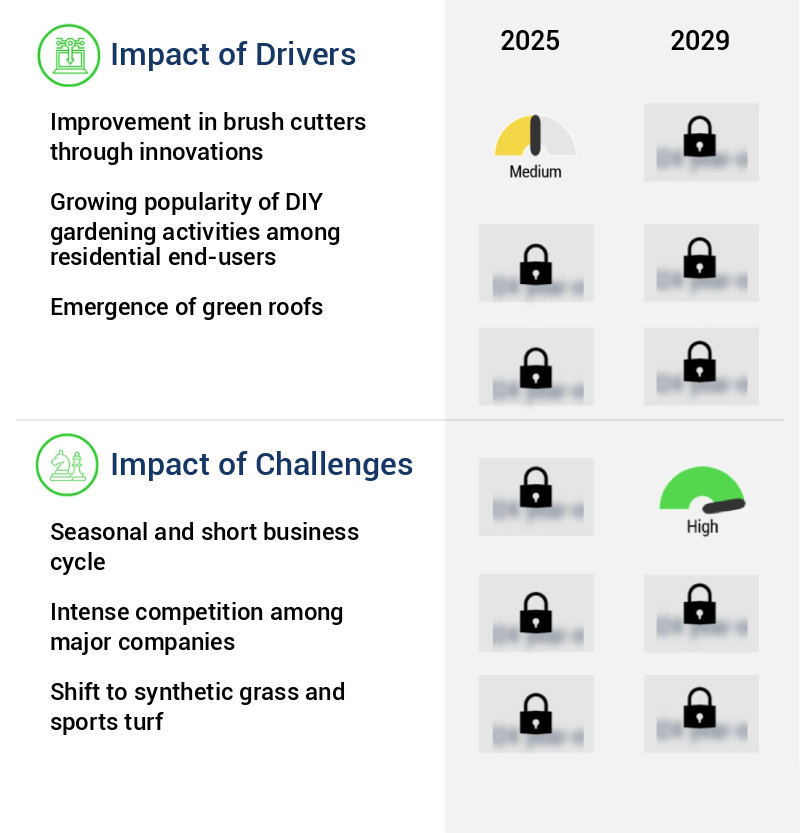
What are the key market drivers leading to the rise in the adoption of Brush Cutter Industry?
- The significant advancements in brush cutter technology, driven by innovations, are the primary catalyst for market growth.
- In the dynamic landscape of the market, competitors continually innovate to address consumer requirements. Technological advancements have led to multifunctional products that offer increased utility. For example, Husqvarna's brush cutters feature Smart Start technology for quick and easy starting. Some models come with an auto return/stop switch and X-Torq technology, which decreases exhaust emissions and enhances fuel efficiency. Brush cutters now boast variable speed technologies, larger blades, low-noise blades, Li-ion battery technologies, and smaller storage spaces.
- These improvements cater to the evolving needs of consumers, ensuring the market remains vibrant and competitive.
What are the market trends shaping the Brush Cutter Industry?
- The adoption of battery-powered brush cutters represents the latest market trend in landscaping equipment. Battery-powered brush cutters are gaining popularity in the landscaping industry.
- Manufacturers in the garden equipment sector are integrating advanced technologies to boost productivity and revenue. Husqvarna Group is a notable player in this trend, focusing on selling more battery-powered products, such as brush cutters, robotic mowers, and hedge trimmers. Battery-powered brush cutters offer several benefits over traditional gas-powered alternatives. They provide greater freedom of movement due to the absence of cords, generate less noise, and require minimal maintenance. These benefits are particularly valuable when using brush cutters for extended periods.
- Consumers are increasingly attracted to battery-powered equipment due to rising fuel prices and environmental concerns. The battery-powered brush cutters typically use batteries with a voltage range of 14 V to 40 V. This shift towards battery-powered garden tools reflects a broader industry trend, as businesses seek to address the evolving needs of consumers and remain competitive.
What challenges does the Brush Cutter Industry face during its growth?
- The seasonal and short business cycles pose a significant challenge to the industry's growth trajectory, requiring strategic planning and adaptability to mitigate their impact.
- The gardening and landscaping market exhibits distinct seasonal trends, with demand peaking in spring and summer due to favorable weather conditions. According to industry data, these seasons account for approximately 60% of annual sales for market leaders like Husqvarna. Conversely, winter months present challenges, including shorter days, reduced sunlight, and potential damage to plants from low temperatures and ice accumulation. This seasonality influences the business activities of landscaping contractors, who often shift focus to alternative services such as leaf cleaning and snow removal during the colder months.
- Despite these seasonal fluctuations, the market continues to evolve, with advancements in technology driving innovation in gardening and landscaping tools and techniques. For instance, Husqvarna's sales of garden and lawn tools during the first two quarters of the year remain robust, showcasing the ongoing demand for efficient and effective solutions in the market.
Exclusive Customer Landscape
The brush cutter market forecasting report includes the adoption lifecycle of the market, covering from the innovator's stage to the laggard's stage. It focuses on adoption rates in different regions based on penetration. Furthermore, the brush cutter market report also includes key purchase criteria and drivers of price sensitivity to help companies evaluate and develop their market growth analysis strategies.
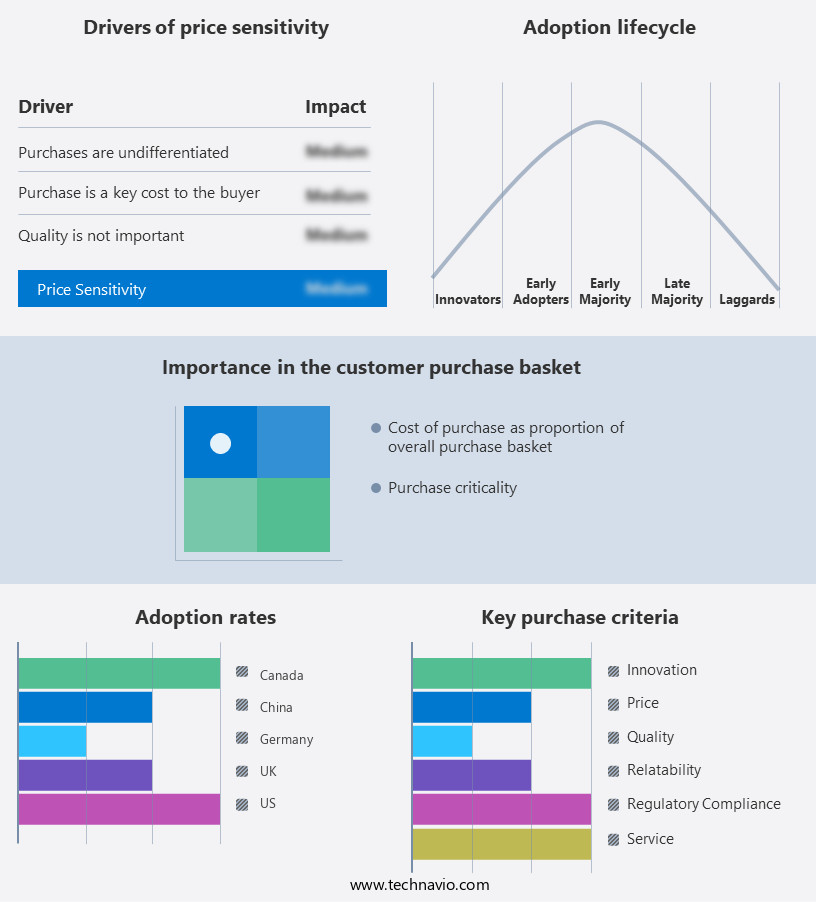
Customer Landscape of Brush Cutter Industry
Competitive Landscape & Market Insights
Companies are implementing various strategies, such as strategic alliances, brush cutter market forecast, partnerships, mergers and acquisitions, geographical expansion, and product/service launches, to enhance their presence in the industry.
Alfred Karcher SE and Co. KG - The 36 Bp brush cutter from the company is a powerful solution for managing difficult mowing tasks, effectively addressing stubborn plant growth and thick undergrowth.
The industry research and growth report includes detailed analyses of the competitive landscape of the market and information about key companies, including:
- Alfred Karcher SE and Co. KG
- ANDREAS STIHL AG and Co. KG
- Briggs and Stratton Corp.
- Deere and Co.
- Emak UK Limited
- Globgro AB
- HONDA India POWER PRODUCTS LTD.
- Husqvarna AB
- KisanKraft Ltd.
- Makita Power Tools India Pvt. Ltd.
- Mitox Garden Machinery UK
- MTD Products India Pvt. Ltd.
- Oregon Tool Inc.
- Robert Bosch GmbH
- Stanley Black and Decker Inc.
- The Toro Co.
- Trapp
- TRUYARD
- Wild Badger Power
- YAMABIKO CORP.
Qualitative and quantitative analysis of companies has been conducted to help clients understand the wider business environment as well as the strengths and weaknesses of key industry players. Data is qualitatively analyzed to categorize companies as pure play, category-focused, industry-focused, and diversified; it is quantitatively analyzed to categorize companies as dominant, leading, strong, tentative, and weak.
Recent Development and News in Brush Cutter Market
- In January 2024, Husqvarna, a leading manufacturer of outdoor power products, launched its new battery-powered brush cutter, the Husqvarna 135Li, expanding its electric line of gardening tools (Husqvarna Press Release).
- In March 2024, Stihl and Bosch, two major brush cutter manufacturers, announced a strategic partnership to jointly develop and produce electric outdoor power equipment, aiming to strengthen their market position in the growing eco-friendly power tools sector (Stihl-Bosch Press Release).
- In April 2025, ECHO Incorporated, a significant player in the market, secured a USD 30 million investment from KPS Capital Partners to support the expansion of its product portfolio and global reach (ECHO Press Release).
- In May 2025, Mahindra, an Indian multinational vehicle manufacturing corporation, received approval from the European Union to manufacture and sell its brush cutters in the European market, marking its entry into the European market (Mahindra Press Release).
Dive into Technavio's robust research methodology, blending expert interviews, extensive data synthesis, and validated models for unparalleled Brush Cutter Market insights. See full methodology.
|
Market Scope
|
|
Report Coverage
|
Details
|
|
Page number
|
217
|
|
Base year
|
2024
|
|
Historic period
|
2019-2023 |
|
Forecast period
|
2025-2029
|
|
Growth momentum & CAGR
|
Accelerate at a CAGR of 3.3%
|
|
Market growth 2025-2029
|
USD 552 million
|
|
Market structure
|
Fragmented
|
|
YoY growth 2024-2025(%)
|
3.2
|
|
Key countries
|
US, Canada, Germany, UK, China, Mexico, Japan, India, France, and Italy
|
|
Competitive landscape
|
Leading Companies, Market Positioning of Companies, Competitive Strategies, and Industry Risks
|
Request Free Sample
Research Analyst Overview
- In the dynamic and evolving market, several key factors influence the adoption and performance of these versatile landscaping tools. One significant aspect is the design of mulching blades, which enable efficient disposal of trimmings within the machine, reducing the need for frequent emptying of collection bags. Another crucial consideration is blade durability, which is often tested through rigorous usage and wear analysis. Cutting deck materials, such as steel or composite, significantly impact blade life and overall machine performance. Safety switch mechanisms and string trimmer attachments are essential features, ensuring user protection and versatility in various applications.
- Wheel diameter variations and blade sharpening techniques contribute to optimized maneuverability and extended blade life. Fuel efficiency ratings, maintenance access points, handlebar adjustability, and maintenance interval schedules are essential factors for operators seeking to minimize downtime and costs. Blade rotation speed, engine starting system, and rotary cutting action contribute to efficient and effective performance. Emission standards compliance, drive system efficiency, and operator safety features are increasingly important considerations as regulations evolve and user safety becomes a priority. Power-to-weight ratio, mulching capability, discharge chute design, and anti-vibration handles further enhance user experience and productivity. Engine displacement options, blade material selection, operational speed range, fuel tank capacity, terrain adaptability, cutting height adjustment, transmission type selection, noise reduction technology, self-propelled mechanism, weight and maneuverability, and vibration damping system are additional features that differentiate brush cutters and influence purchasing decisions.
What are the Key Data Covered in this Brush Cutter Market Research and Growth Report?
-
What is the expected growth of the Brush Cutter Market between 2025 and 2029?
-
What segmentation does the market report cover?
-
The report segmented by End-user (Residential and Commercial), Type (Cordless brush cutter and Corded brush cutter), Product Type (Handheld, Walk-behind, and Tow-behind), Geography (North America, Europe, APAC, Middle East and Africa, and South America), Power Source (Gas-Powered, Electric, and Battery-Powered), and Application Type (Residential, Commercial, Agricultural, and Forestry)
-
Which regions are analyzed in the report?
-
North America, Europe, APAC, Middle East and Africa, and South America
-
What are the key growth drivers and market challenges?
-
Who are the major players in the Brush Cutter Market?
-
Key Companies Alfred Karcher SE and Co. KG, ANDREAS STIHL AG and Co. KG, Briggs and Stratton Corp., Deere and Co., Emak UK Limited, Globgro AB, HONDA India POWER PRODUCTS LTD., Husqvarna AB, KisanKraft Ltd., Makita Power Tools India Pvt. Ltd., Mitox Garden Machinery UK, MTD Products India Pvt. Ltd., Oregon Tool Inc., Robert Bosch GmbH, Stanley Black and Decker Inc., The Toro Co., Trapp, TRUYARD, Wild Badger Power, and YAMABIKO CORP.
Market Research Insights
- The market encompasses a diverse range of outdoor power equipment designed for maintaining vegetation in various terrains. Two key performance indicators in this market are wheel traction performance and brush cutter lifespan. According to industry data, brush cutters with superior wheel traction deliver an average operational lifespan of 3,000 hours, while those with less effective traction systems typically last only 1,500 hours. Operator comfort features and ease of use are also essential considerations. For instance, brush cutters with ergonomic handlebars, adjustable throttle controls, and vibration reduction technologies can enhance user experience and increase productivity. Additionally, noise level certification, engine reliability factors, and fuel consumption rate are critical aspects that influence the overall efficiency of operation.
- Cutting width capability, engine power rating, and power output consistency are essential performance metrics. High-performance brush cutters can offer a cutting width of up to 21 inches and a power output of 10 horsepower, providing superior productivity and efficiency. Furthermore, blade life expectancy, fuel tank design, and cutting head design are crucial factors that contribute to the durability of components and overall machine longevity. Safety features evaluation, such as automatic shut-off mechanisms and protective shields, are vital for ensuring operator safety. String trimmer compatibility, transmission reliability, and blade sharpness retention are other essential factors that impact the overall performance and cost-effectiveness of brush cutters.
We can help! Our analysts can customize this brush cutter market research report to meet your requirements.
Get in touch
1 Executive Summary
- 1.1 Market overview
- Executive Summary - Chart on Market Overview
- Executive Summary - Data Table on Market Overview
- Executive Summary - Chart on Global Market Characteristics
- Executive Summary - Chart on Market by Geography
- Executive Summary - Chart on Market Segmentation by End-user
- Executive Summary - Chart on Market Segmentation by Type
- Executive Summary - Chart on Market Segmentation by Product Type
- Executive Summary - Chart on Incremental Growth
- Executive Summary - Data Table on Incremental Growth
- Executive Summary - Chart on Company Market Positioning
2 Technavio Analysis
- 2.1 Analysis of price sensitivity, lifecycle, customer purchase basket, adoption rates, and purchase criteria
- Analysis of price sensitivity, lifecycle, customer purchase basket, adoption rates, and purchase criteria
- 2.2 Criticality of inputs and Factors of differentiation
- Overview on criticality of inputs and factors of differentiation
- 2.3 Factors of disruption
- Overview on factors of disruption
- 2.4 Impact of drivers and challenges
- Impact of drivers and challenges in 2024 and 2029
3 Market Landscape
- 3.1 Market ecosystem
- Parent Market
- Data Table on - Parent Market
- 3.2 Market characteristics
- Market characteristics analysis
4 Market Sizing
- 4.1 Market definition
- Offerings of companies included in the market definition
- 4.2 Market segment analysis
- 4.4 Market outlook: Forecast for 2024-2029
- Chart on Global - Market size and forecast 2024-2029 ($ million)
- Data Table on Global - Market size and forecast 2024-2029 ($ million)
- Chart on Global Market: Year-over-year growth 2024-2029 (%)
- Data Table on Global Market: Year-over-year growth 2024-2029 (%)
5 Historic Market Size
- 5.1 Global Brush Cutter Market 2019 - 2023
- Historic Market Size - Data Table on Global Brush Cutter Market 2019 - 2023 ($ million)
- 5.2 End-user segment analysis 2019 - 2023
- Historic Market Size - End-user Segment 2019 - 2023 ($ million)
- 5.3 Type segment analysis 2019 - 2023
- Historic Market Size - Type Segment 2019 - 2023 ($ million)
- 5.4 Product Type segment analysis 2019 - 2023
- Historic Market Size - Product Type Segment 2019 - 2023 ($ million)
- 5.5 Geography segment analysis 2019 - 2023
- Historic Market Size - Geography Segment 2019 - 2023 ($ million)
- 5.6 Country segment analysis 2019 - 2023
- Historic Market Size - Country Segment 2019 - 2023 ($ million)
6 Qualitative Analysis
- 6.1 The AI impact on global brush cutter market
7 Five Forces Analysis
- 7.1 Five forces summary
- Five forces analysis - Comparison between 2024 and 2029
- 7.2 Bargaining power of buyers
- Bargaining power of buyers - Impact of key factors 2024 and 2029
- 7.3 Bargaining power of suppliers
- Bargaining power of suppliers - Impact of key factors in 2024 and 2029
- 7.4 Threat of new entrants
- Threat of new entrants - Impact of key factors in 2024 and 2029
- 7.5 Threat of substitutes
- Threat of substitutes - Impact of key factors in 2024 and 2029
- 7.6 Threat of rivalry
- Threat of rivalry - Impact of key factors in 2024 and 2029
- 7.7 Market condition
- Chart on Market condition - Five forces 2024 and 2029
8 Market Segmentation by End-user
- 8.1 Market segments
- Chart on End-user - Market share 2024-2029 (%)
- Data Table on End-user - Market share 2024-2029 (%)
- 8.2 Comparison by End-user
- Chart on Comparison by End-user
- Data Table on Comparison by End-user
- 8.3 Residential - Market size and forecast 2024-2029
- Chart on Residential - Market size and forecast 2024-2029 ($ million)
- Data Table on Residential - Market size and forecast 2024-2029 ($ million)
- Chart on Residential - Year-over-year growth 2024-2029 (%)
- Data Table on Residential - Year-over-year growth 2024-2029 (%)
- 8.4 Commercial - Market size and forecast 2024-2029
- Chart on Commercial - Market size and forecast 2024-2029 ($ million)
- Data Table on Commercial - Market size and forecast 2024-2029 ($ million)
- Chart on Commercial - Year-over-year growth 2024-2029 (%)
- Data Table on Commercial - Year-over-year growth 2024-2029 (%)
- 8.5 Market opportunity by End-user
- Market opportunity by End-user ($ million)
- Data Table on Market opportunity by End-user ($ million)
9 Market Segmentation by Type
- 9.1 Market segments
- Chart on Type - Market share 2024-2029 (%)
- Data Table on Type - Market share 2024-2029 (%)
- 9.2 Comparison by Type
- Chart on Comparison by Type
- Data Table on Comparison by Type
- 9.3 Cordless brush cutter - Market size and forecast 2024-2029
- Chart on Cordless brush cutter - Market size and forecast 2024-2029 ($ million)
- Data Table on Cordless brush cutter - Market size and forecast 2024-2029 ($ million)
- Chart on Cordless brush cutter - Year-over-year growth 2024-2029 (%)
- Data Table on Cordless brush cutter - Year-over-year growth 2024-2029 (%)
- 9.4 Corded brush cutter - Market size and forecast 2024-2029
- Chart on Corded brush cutter - Market size and forecast 2024-2029 ($ million)
- Data Table on Corded brush cutter - Market size and forecast 2024-2029 ($ million)
- Chart on Corded brush cutter - Year-over-year growth 2024-2029 (%)
- Data Table on Corded brush cutter - Year-over-year growth 2024-2029 (%)
- 9.5 Market opportunity by Type
- Market opportunity by Type ($ million)
- Data Table on Market opportunity by Type ($ million)
10 Market Segmentation by Product Type
- 10.1 Market segments
- Chart on Product Type - Market share 2024-2029 (%)
- Data Table on Product Type - Market share 2024-2029 (%)
- 10.2 Comparison by Product Type
- Chart on Comparison by Product Type
- Data Table on Comparison by Product Type
- 10.3 Handheld - Market size and forecast 2024-2029
- Chart on Handheld - Market size and forecast 2024-2029 ($ million)
- Data Table on Handheld - Market size and forecast 2024-2029 ($ million)
- Chart on Handheld - Year-over-year growth 2024-2029 (%)
- Data Table on Handheld - Year-over-year growth 2024-2029 (%)
- 10.4 Walk-behind - Market size and forecast 2024-2029
- Chart on Walk-behind - Market size and forecast 2024-2029 ($ million)
- Data Table on Walk-behind - Market size and forecast 2024-2029 ($ million)
- Chart on Walk-behind - Year-over-year growth 2024-2029 (%)
- Data Table on Walk-behind - Year-over-year growth 2024-2029 (%)
- 10.5 Tow-behind - Market size and forecast 2024-2029
- Chart on Tow-behind - Market size and forecast 2024-2029 ($ million)
- Data Table on Tow-behind - Market size and forecast 2024-2029 ($ million)
- Chart on Tow-behind - Year-over-year growth 2024-2029 (%)
- Data Table on Tow-behind - Year-over-year growth 2024-2029 (%)
- 10.6 Market opportunity by Product Type
- Market opportunity by Product Type ($ million)
- Data Table on Market opportunity by Product Type ($ million)
11 Customer Landscape
- 11.1 Customer landscape overview
- Analysis of price sensitivity, lifecycle, customer purchase basket, adoption rates, and purchase criteria
12 Geographic Landscape
- 12.1 Geographic segmentation
- Chart on Market share by geography 2024-2029 (%)
- Data Table on Market share by geography 2024-2029 (%)
- 12.2 Geographic comparison
- Chart on Geographic comparison
- Data Table on Geographic comparison
- 12.3 North America - Market size and forecast 2024-2029
- Chart on North America - Market size and forecast 2024-2029 ($ million)
- Data Table on North America - Market size and forecast 2024-2029 ($ million)
- Chart on North America - Year-over-year growth 2024-2029 (%)
- Data Table on North America - Year-over-year growth 2024-2029 (%)
- 12.4 Europe - Market size and forecast 2024-2029
- Chart on Europe - Market size and forecast 2024-2029 ($ million)
- Data Table on Europe - Market size and forecast 2024-2029 ($ million)
- Chart on Europe - Year-over-year growth 2024-2029 (%)
- Data Table on Europe - Year-over-year growth 2024-2029 (%)
- 12.5 APAC - Market size and forecast 2024-2029
- Chart on APAC - Market size and forecast 2024-2029 ($ million)
- Data Table on APAC - Market size and forecast 2024-2029 ($ million)
- Chart on APAC - Year-over-year growth 2024-2029 (%)
- Data Table on APAC - Year-over-year growth 2024-2029 (%)
- 12.6 Middle East and Africa - Market size and forecast 2024-2029
- Chart on Middle East and Africa - Market size and forecast 2024-2029 ($ million)
- Data Table on Middle East and Africa - Market size and forecast 2024-2029 ($ million)
- Chart on Middle East and Africa - Year-over-year growth 2024-2029 (%)
- Data Table on Middle East and Africa - Year-over-year growth 2024-2029 (%)
- 12.7 South America - Market size and forecast 2024-2029
- Chart on South America - Market size and forecast 2024-2029 ($ million)
- Data Table on South America - Market size and forecast 2024-2029 ($ million)
- Chart on South America - Year-over-year growth 2024-2029 (%)
- Data Table on South America - Year-over-year growth 2024-2029 (%)
- 12.8 US - Market size and forecast 2024-2029
- Chart on US - Market size and forecast 2024-2029 ($ million)
- Data Table on US - Market size and forecast 2024-2029 ($ million)
- Chart on US - Year-over-year growth 2024-2029 (%)
- Data Table on US - Year-over-year growth 2024-2029 (%)
- 12.9 Germany - Market size and forecast 2024-2029
- Chart on Germany - Market size and forecast 2024-2029 ($ million)
- Data Table on Germany - Market size and forecast 2024-2029 ($ million)
- Chart on Germany - Year-over-year growth 2024-2029 (%)
- Data Table on Germany - Year-over-year growth 2024-2029 (%)
- 12.10 Canada - Market size and forecast 2024-2029
- Chart on Canada - Market size and forecast 2024-2029 ($ million)
- Data Table on Canada - Market size and forecast 2024-2029 ($ million)
- Chart on Canada - Year-over-year growth 2024-2029 (%)
- Data Table on Canada - Year-over-year growth 2024-2029 (%)
- 12.11 UK - Market size and forecast 2024-2029
- Chart on UK - Market size and forecast 2024-2029 ($ million)
- Data Table on UK - Market size and forecast 2024-2029 ($ million)
- Chart on UK - Year-over-year growth 2024-2029 (%)
- Data Table on UK - Year-over-year growth 2024-2029 (%)
- 12.12 China - Market size and forecast 2024-2029
- Chart on China - Market size and forecast 2024-2029 ($ million)
- Data Table on China - Market size and forecast 2024-2029 ($ million)
- Chart on China - Year-over-year growth 2024-2029 (%)
- Data Table on China - Year-over-year growth 2024-2029 (%)
- 12.13 Mexico - Market size and forecast 2024-2029
- Chart on Mexico - Market size and forecast 2024-2029 ($ million)
- Data Table on Mexico - Market size and forecast 2024-2029 ($ million)
- Chart on Mexico - Year-over-year growth 2024-2029 (%)
- Data Table on Mexico - Year-over-year growth 2024-2029 (%)
- 12.14 Japan - Market size and forecast 2024-2029
- Chart on Japan - Market size and forecast 2024-2029 ($ million)
- Data Table on Japan - Market size and forecast 2024-2029 ($ million)
- Chart on Japan - Year-over-year growth 2024-2029 (%)
- Data Table on Japan - Year-over-year growth 2024-2029 (%)
- 12.15 India - Market size and forecast 2024-2029
- Chart on India - Market size and forecast 2024-2029 ($ million)
- Data Table on India - Market size and forecast 2024-2029 ($ million)
- Chart on India - Year-over-year growth 2024-2029 (%)
- Data Table on India - Year-over-year growth 2024-2029 (%)
- 12.16 France - Market size and forecast 2024-2029
- Chart on France - Market size and forecast 2024-2029 ($ million)
- Data Table on France - Market size and forecast 2024-2029 ($ million)
- Chart on France - Year-over-year growth 2024-2029 (%)
- Data Table on France - Year-over-year growth 2024-2029 (%)
- 12.17 Italy - Market size and forecast 2024-2029
- Chart on Italy - Market size and forecast 2024-2029 ($ million)
- Data Table on Italy - Market size and forecast 2024-2029 ($ million)
- Chart on Italy - Year-over-year growth 2024-2029 (%)
- Data Table on Italy - Year-over-year growth 2024-2029 (%)
- 12.18 Market opportunity by geography
- Market opportunity by geography ($ million)
- Data Tables on Market opportunity by geography ($ million)
13 Drivers, Challenges, and Opportunity/Restraints
- 13.3 Impact of drivers and challenges
- Impact of drivers and challenges in 2024 and 2029
- 13.4 Market opportunities/restraints
14 Competitive Landscape
- 14.2 Competitive Landscape
- Overview on criticality of inputs and factors of differentiation
- 14.3 Landscape disruption
- Overview on factors of disruption
- 14.4 Industry risks
- Impact of key risks on business
15 Competitive Analysis
- 15.2 Company ranking index
- 15.3 Market positioning of companies
- Matrix on companies position and classification
- 15.4 Alfred Karcher SE and Co. KG
- Alfred Karcher SE and Co. KG - Overview
- Alfred Karcher SE and Co. KG - Product / Service
- Alfred Karcher SE and Co. KG - Key offerings
- SWOT
- 15.5 ANDREAS STIHL AG and Co. KG
- ANDREAS STIHL AG and Co. KG - Overview
- ANDREAS STIHL AG and Co. KG - Product / Service
- ANDREAS STIHL AG and Co. KG - Key offerings
- SWOT
- 15.6 Deere and Co.
- Deere and Co. - Overview
- Deere and Co. - Business segments
- Deere and Co. - Key news
- Deere and Co. - Key offerings
- Deere and Co. - Segment focus
- SWOT
- 15.7 Emak UK Limited
- Emak UK Limited - Overview
- Emak UK Limited - Product / Service
- Emak UK Limited - Key offerings
- SWOT
- 15.8 HONDA INDIA POWER PRODUCTS LTD.
- HONDA INDIA POWER PRODUCTS LTD. - Overview
- HONDA INDIA POWER PRODUCTS LTD. - Product / Service
- HONDA INDIA POWER PRODUCTS LTD. - Key offerings
- SWOT
- 15.9 Husqvarna AB
- Husqvarna AB - Overview
- Husqvarna AB - Business segments
- Husqvarna AB - Key news
- Husqvarna AB - Key offerings
- Husqvarna AB - Segment focus
- SWOT
- 15.10 KisanKraft Ltd.
- KisanKraft Ltd. - Overview
- KisanKraft Ltd. - Product / Service
- KisanKraft Ltd. - Key offerings
- SWOT
- 15.11 Makita Power Tools India Pvt. Ltd.
- Makita Power Tools India Pvt. Ltd. - Overview
- Makita Power Tools India Pvt. Ltd. - Product / Service
- Makita Power Tools India Pvt. Ltd. - Key offerings
- SWOT
- 15.12 MTD Products India Pvt. Ltd.
- MTD Products India Pvt. Ltd. - Overview
- MTD Products India Pvt. Ltd. - Product / Service
- MTD Products India Pvt. Ltd. - Key offerings
- SWOT
- 15.13 Oregon Tool Inc.
- Oregon Tool Inc. - Overview
- Oregon Tool Inc. - Product / Service
- Oregon Tool Inc. - Key offerings
- SWOT
- 15.14 Robert Bosch GmbH
- Robert Bosch GmbH - Overview
- Robert Bosch GmbH - Product / Service
- Robert Bosch GmbH - Key news
- Robert Bosch GmbH - Key offerings
- SWOT
- 15.15 Stanley Black and Decker Inc.
- Stanley Black and Decker Inc. - Overview
- Stanley Black and Decker Inc. - Business segments
- Stanley Black and Decker Inc. - Key news
- Stanley Black and Decker Inc. - Key offerings
- Stanley Black and Decker Inc. - Segment focus
- SWOT
- 15.16 The Toro Co.
- The Toro Co. - Overview
- The Toro Co. - Business segments
- The Toro Co. - Key news
- The Toro Co. - Key offerings
- The Toro Co. - Segment focus
- SWOT
- 15.17 Wild Badger Power
- Wild Badger Power - Overview
- Wild Badger Power - Product / Service
- Wild Badger Power - Key offerings
- SWOT
- 15.18 YAMABIKO CORP.
- YAMABIKO CORP. - Overview
- YAMABIKO CORP. - Business segments
- YAMABIKO CORP. - Key offerings
- YAMABIKO CORP. - Segment focus
- SWOT
16 Appendix
- 16.2 Inclusions and exclusions checklist
- Inclusions checklist
- Exclusions checklist
- 16.3 Currency conversion rates for US$
- Currency conversion rates for US$
- 16.4 Research methodology
- 16.7 Validation techniques employed for market sizing
- Validation techniques employed for market sizing
- 16.9 360 degree market analysis
- 360 degree market analysis
- 16.10 List of abbreviations







![]() Get the report (PDF) sent to your email within minutes.
Get the report (PDF) sent to your email within minutes.
Complimentary full Excel data with your report purchase.